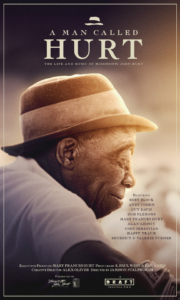From the Nashville Film Festival
A Man Called Hurt: The Life and Music of Mississippi John Hurt
A Man Called Hurt: The Life and Music of Mississippi John Hurt begins as a comfortably muted scene in an old-time country home in Avalon, Mississippi. “Frankie” is playing on the crank-up Victrola. The film ends with “Since I Laid my Burden Down” playing in the background as the Victrola image fades.
In this 2024 release by Draft Films, a Tennessee film company, in conjunction with the Mississippi John Hurt Foundation, Jamison Stalsworth and Alex Oliver have created a lovingly rendered portrait of the life and career of Mississippi John Hurt, a soft-spoken bluesman from the Mississippi Delta. They are known for their short film Love, Trails, and Dinosaurs, a 2019 documentary of the 900-mile Smoky Mountain hiking adventure of a mother and her autistic son. In that film, Oliver served as director, while Stalsworth was one of the producers.
In “A Man Called Hurt,” both took on multiple roles as direct, editor, and cinematographer (Stalsworth), and creative director and cinematographer (Oliver). Additionally both were active camera operators alongside Ronald Levy. They achieved this moving tribute working with Hurt’s granddaughter Mary Frances Hurt, executive director of the Hurt Foundation
Like most country blues musicians, John Smith Hurt was self-taught. “I shall never forget,” he delicately reminisced about first picking up the guitar of a family friend at the age of eight. Four years earlier, Hurt, the grandson of enslaved people had lost his father to the Jim Crow-era scourge of lynching. He would later lose his only daughter to the gun of an abusive husband. His promising music career with Okeh Records was stopped in its tracks by the Great Depression. Despite all this tragedy and trauma, when Greenwich Village blues devotees sought him out in the folk-revival era of the 1960s, they found a warm, gentle man with a talent that had been preserved free of bitterness.
How was this possible? Benedict Turner, of the Piedmont Bluz Acoustic Duo, approaches the truth when he notes that Hurt’s “gentle approach to storytelling came across as if he was talking to his family sitting on the porch, just so lovingly.” Don Flemons, a folk musician self-billed as “The American Songster” further adds, “Even though he has sort of a sunny disposition in the way that he picks them, he’s still telling some hard truths…” This certainly applies at eyebrow-raising levels in “Ain’t No Tellin’” where he good-naturedly warns his friend that a good girl they know “might shoot you, might cut and starve you too, ain’t no tellin’ what she might do.”

Hurt’s granddaughter confirmed both points of view. As she grew up, she recalls “Daddy John” playing for his children and grandchildren under the mulberry tree on Sundays. Later, after this “PG” set, she learned that he’d play more “mature” music for the grownups. Raised by a hard-working mother, she also adds the intriguing point that Hurt often took a confident female perspective in songs like “I’m Satisfied.” The overall picture was one of personal dedication to family shown in and through his music.
The beauty of the music is reflected in the film’s cinematography, transitioning subtly from aerial shots of old-growth forests, cornfields, and swamplands of Mississippi, to intimate shots of family photos and personal objects in the small museum his granddaughter preserved for over two decades. Delicately interspersed among these images were two important features of the film, audio and video clips from Hurt’s performances, and personal vignettes from a varied roster of talented musicians, all devoted to Hurt and his music.
That roster includes Pete Seeger radio-interviewing Hurt, and John Sebastian, founder and lead singer for Sixties pop group, The Lovin’ Spoonful. He’d met Hurt as a teenager and performed harmonica with him at folk festivals, eventually taking his group’s name from one of Hurt’s songs. Unlike many film documentaries about music, the directors played what we in the South might call a “healthy portion” or a “gracious plenty” of each song.
The music and images complemented one another as the narration traced the influence of his unique finger-picking style. He used his thumb alternating strings for a bass line, while picking his melody with the index and middle fingers. This is in keeping with the Mississippi Delta blues style where the soft voice plays simultaneously with, or in alternation with, the guitar melody. But there is also a flavor of East Tennessee Piedmont blues with its hopping bass line and the syncopated melodies that were the grandchildren of ragtime.
Granddaughter Mary Frances’ tales of the difficulties in maintaining his museum are thankfully followed, post-credits, with Hurt’s cute alphabet song, “Chicken.” Then, with white font on a coal-black background, the filmmakers announce thrilling news. In early 2024, the museum was named a “historical landmark” by the National Register of Historic Places.
However, the tragedy that was an ongoing feature of Hurt’s life would not be denied. The day following this great honor, the museum burnt to the ground. Authorities have yet to determine a cause for why a museum that had stood undamaged for over twenty years, should suddenly catch fire. This gut-punch somehow seemed of a piece with Hurt’s life and this film—triumph, tragedy, love, loss. But his music survives.
Plans are in place to rebuild the museum. To help, contact: www.msjohnhurtfoundation.org
- About the Author
- Latest Posts
Y Kendall is a Stanford-educated musicologist, specializing in dance history who recently earned an MFA in Creative Nonfiction at Columbia University, studying nonfiction writing with Ben Ratliff and Margo Jefferson. Kendall’s diverse works have been published in Alchemy: Journal of Translation, Columbia Journal, Mitos Magazín, The Hunger Mountain Review, and The Salt Collective, among others. Born and raised in Tennessee, Kendall now lives near Nashville, freelancing as a flutist and writer, while caregiving for relatives.




